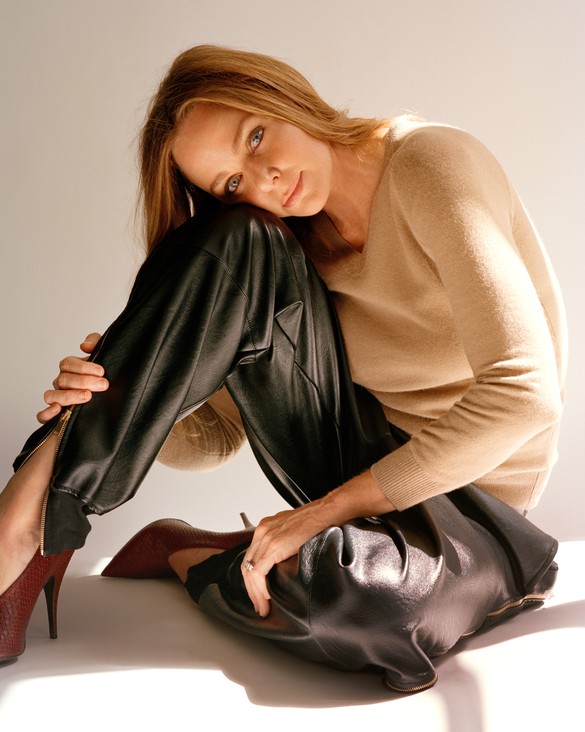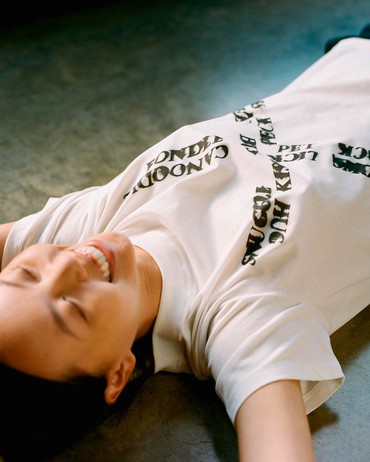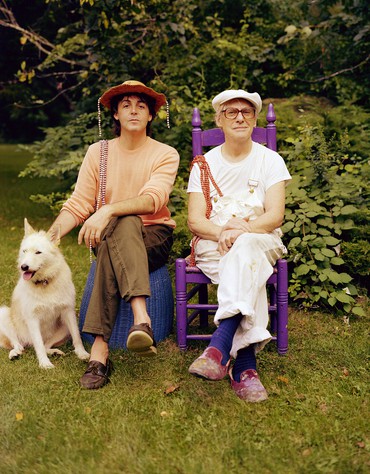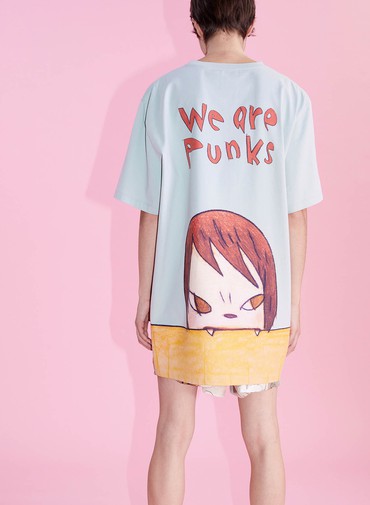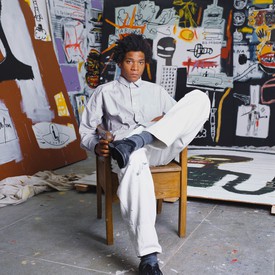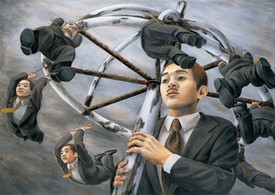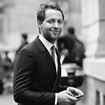
Derek Blasberg is a writer, fashion editor, and New York Times best-selling author. He has been with Gagosian since 2014, and is currently the executive editor of Gagosian Quarterly.
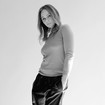
Born and raised in London and the English countryside, Stella McCartney graduated from Central Saint Martins, London, in 1995. A signature style of sharp tailoring, natural confidence, and sexy femininity was immediately apparent in her first collection, and in 1997, after only two collections, she was appointed the creative director of Chloé in Paris. In 2001, in partnership with the luxury-goods company Kering, McCartney launched her own fashion house under her name.
Derek BlasbergWhere are you right now, Stella?
Stella McCartneyI’m on my organic farm in the countryside in England.
DBPresumably that’s where you’ve been for the past forever?
SMcCYeah, I’ve been here pretty much from the start of covid.
DBBeing a designer, your creative process is so affected by what you see and where you go. How has it been to work without discovering inspirations on the road?
SMcCI think many people in our industry felt for a long time that the pace was relentless, like we never got a second to stop and think. So, in lockdown, I finally found myself with a second to think and it was like, Now what? But it was quite refreshing and maybe even shocking. I asked myself, “Why do I do this? Why does anyone care about this industry? What’s important about what I do?” I realized that this is a critical moment in the history of our planet. I have an important role to play in the industry, I’m proud of my unique position in it—my staunch advocacy of the environment and its protection, treating animals with respect, and coming to business in a more mindful way. It felt like this was an important place for me to be right now and I have a reason to do what I do.
DBIs that what inspired the manifesto that you released earlier this year?
SMcCYes, exactly. I wrote that manifesto in the middle of the night when I couldn’t sleep. It came to me and I was suddenly so excited and fueled by creativity. It’s an alphabet of words that stand for the brand’s core value system: A is for accountability, B is for British, and so on.
DBYou had a great interview with Christiane Amanpour on CNN, which isn’t a regular forum for fashion designers.
SMcCOh, why thank you!
DBThat’s what’s so great about what you do: you’re not just a fashion designer, you’re an ecowarrior, a political figure. You can show up on CNN as well as you can show up on Vogue as well as you can show up in the Quarterly.
SMcCThat came to light at the beginning of covid. Creativity fell into place for me. I felt inspired to be alive in this moment, and to have a career as a working mother and as a woman. I have a voice and I have a platform that’s powerful. For the first time in maybe forever, I realized I had my family, I had my fashion family at work, and then I had this larger community that I don’t get to connect with often in the fashion context. All of my friends are artists, essentially, and actually all of them work in isolation. I called David Hockney and I’m like, “How are you doing?” He’s like, “Well, I’m just doing what I always do.” I called the musicians I knew, like my dad, and he’s like, “Well, I just write songs on my own anyway.” And it occurred to me that creativity is actually at the core of everything we all do. “What does the word ‘accountable’ mean to you, Rashid Johnson? Or ‘kindness,’ Jeff Koons? Or ‘timelessness,’ William Eggleston? Or ‘effortlessness,’ Cindy Sherman?”
DBYou had a Jerry Maguire moment. You were suddenly, late in the night, fueled by passion, creativity, making a manifesto.
SMcCI don’t even know if I like the word “manifesto”! It’s a bit of an overused word now. But I had clarity and I was afforded this moment and I went with it. Of course, now, I’m completely overloaded with all the crap again and it feels like a million years ago.
DBThis isn’t your first conversation with artists. One of my favorite things to do with you is reminisce about your whole family’s longtime connection to contemporary art. Your mother’s father was the lawyer to all those incredible—
SMcCMy grandpa, Lee Eastman! He was an entertainment lawyer and represented all kinds of great artists, as well as actors, writers, all of the great creatives of that period in New York. He used to write Quincy [Jones]’s paycheck when Quincy was only a kid. Quincy always reminds me of that when I see him. He also worked with the Abstract Expressionists. So he represented de Kooning and built his studio out in the Hamptons, in the Springs. So, yeah, I was hanging out with de Kooning all my life growing up. He drew all these charcoals of my mom because he and my mom got on really well. Later my dad became good friends with Bill too.
DBBill?
SMcCYes! We called him Bill, that’s how much we hung out! But my grandpa represented Franz Kline and Robert Motherwell and Joseph Cornell and Josef Albers and Mark Rothko. I mean, it was insane really. We grew up with all of that around us as kids.
DBThere’s an amazing picture your mom took of your dad and de Kooning.
SMcCAt his studio on the chairs. I have a copy of that, it’s beautiful. It’s funny because I still go to the studio every summer and I can still go out there and sit on those chairs.
DBOf course, they still have the chairs!
SMcCYeah, they’re still there. It’s amazing, and now it’s his grandchildren out there. Sadly, his daughter passed away.
DBThat must have been incredible to see from such a young age.
SMcCLooking back now, I feel very privileged. But back then it was just a room and some chairs. Know what’s crazy? My grandpa used to swap his time in law fees for art. He was one of the last true collectors. It was all for the love of it. None of it was monetary. He’d come home with a de Kooning and my grandma would be like, “What the fuck is this? How am I going to feed the kids with a painting?” But when he passed away, he had the largest private collection of Abstract Expressionism.
DBDo you know where some of the paintings are now?
SMcCThey pop up. I’ve had friends, who I won’t mention, say to me, “Oh, I’m going to buy your grandfather’s Kline,” and I’m like, “Noooo!” I remember we’d come home from de Kooning’s studio in the ’90s and some critics had accused him of having Alzheimer’s because he’d gone into the white period. I remember the discussions because my grandfather was his lawyer. They’d say, “Is this worthless, this art?” Which is actually so poetic and beautiful and breathtaking. And of course the critics were wrong. I remember being so moved by those works and now I appreciate living and breathing that then.
DBHas your perspective on the art world changed since then?
SMcCIt’s sort of fluid for me. For example, Leo Castelli was always around in our life when I was a child. And that turned into Larry Gagosian, maybe with Tony Shafrazi and some other characters in between. In London, Robert Fraser was the equivalent, and he was one of my mom’s best friends. My father bought some Magrittes off of him. The art world is like a whole separate life. Peter Blake is my godfather. It’s all still in my life. I mean, Ringo [Starr] is a huge [George] Condo collector! [Allen] Ginsberg and all these other kinds of artists were around constantly too. [David] Bowie and music artists. It was such a huge influence on me.
DBAnd it continues now.
SMCCOf course it does! I grew up, went to college, and became a fashion designer and found my own little gang. Urs Fischer! He’s done campaigns with me. I met Jeff Koons at Larry’s house for dinner one summer. I met Ed Ruscha when I wrote a fan letter. Cindy Sherman I met in the Springs and I go and see her every summer. I’ve accumulated an incredible collection of work by amazing artists and I feel so blessed I’ve been able to work with many of them.
DBSpeaking about Cindy, I interviewed her last year and she said you were one of the easiest designers to collaborate with. You literally sent her a box of clothes and were like—
SMCCI sure did. Did you see the stuff we did?
DBHow could I not? There was a big portrait right in the National Portrait Gallery, it was the opening image!
SMCCI’m very sensitive to being used and using people of talent. I’m aware of the fashion industry hooking on to people and selling them out. And I have a real allergy to it. In fashion, it’s typical for a brand to think, “Omigod, I’m going to get So-and-So to do this bag and I’m going to pay them a million pounds.” And I feel it, as a consumer, I’m like, “Ew, I don’t want that. That feels like dirty money in a sense.” Every single relationship I’ve been blessed to have is an art-based relationship. And I value that. An artist will remind me of what I’m saying, rather than what I think I’m saying. I just work in a way with artists where we’re just enjoying it. With Cindy, I was like, “I love you, I worship you, do whatever you want.” And she was like, “I’ve never been a man.” And I was like, “That’s it, we’ll send you the menswear.” It was just beautiful and it went on for years. I never bothered her about it. I don’t have an ulterior motive.
DBTalk to me about the Yoshitomo Nara collection. I see you’re wearing the Nara shirt now.
SMCCIt was so easy and effortless. I love his work. I’m a fan. He’s punk. A real one, too! I haven’t had the chance to work with many artists in Asia and I was longing for a little bit of that Japanese Zen culture, and his love of music and the references to British punk in his work, and the innocence and the childishness. I’m a huge fan of what he does. And underlying it all is this wonderful respect for nature. To be the first fashion designer that he’s ever collaborated with is absolutely blowing my brains away, I can’t quite believe it.
DBIn the past year, there have been so many new conversations around sustainability, fashion’s impact on the world, greenwashing. To a certain degree do you feel like, “Oh, welcome to this party I’ve been at for twenty years”?
SMcCI don’t know what to say about that, really. We all arrive at things at different stages, don’t we? I was hugely blessed to grow up with that level of awareness. I admire people more who didn’t grow up in a kind of rock ’n’ roll, vegetarian, family-on-a-farm context. I acquired it through my upbringing. And while there are so many people now at the party, we still have so much to do. I’m very aware that there’s a lot of greenwashing going on. There needs to be a little more encouragement in the industry. There needs to be more policy to support changes that are much needed. But it feels like people can’t avoid it now and they’re deeply invested in being part of the conversation and not missing the boat. So that’s good.
DBMy last question: When people ask you “is fashion art?”, what are your responses?
SMcCIt’s in the eye of the beholder. I would never be that presumptuous to say I’m an artist. I mean, the word “art” is so weighty to me. What is and what isn’t art? That’s the beauty of art. It’s not for me to say.
DBEven if you’re not an artist, you’re many other things to me.
SMcCHonestly, I don’t know what the fuck I am anymore! I know I’m a mom and a wife and a mate. Other than that I couldn’t tell you.
